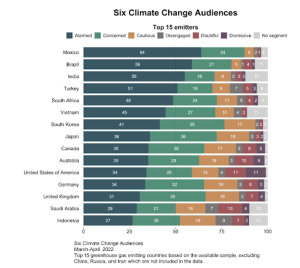My name is Samantha Wyman and I am working with YVSC as a Climate Action Plan Collaborative Intern. As the acting coordinator for Routt County’s Climate Action Plan, our organization is leading the community engagement piece of the initiative. During my internship, I will be collecting information on best practices for measuring public perception on climate change, communicating climate change, and motivating climate action. I will synthesize this research into a literature review and a formal proposal with my recommendation for the Climate Action Plan collaborative. An important part of my project is understanding how climate change perceptions are formed. Below I discuss one of the keystone studies published on US public opinion of climate change.
collaborative. An important part of my project is understanding how climate change perceptions are formed. Below I discuss one of the keystone studies published on US public opinion of climate change.
In 2020, researchers from Yale University and George Mason University set out to develop an effective machine learning tool for classifying individuals into different segments of the population based upon their climate change perceptions. Segmenting individuals into subgroups based on their beliefs is an effective tool for creating targeted messaging. This allows the messenger to communicate with subgroups by emphasizing their shared values and interests. For example, YVSC might frame global warming as a river water related issue when communicating climate action initiatives to a subgroup of Routt County fisherman. In order to develop this segmentation tool, Yale and George Mason researchers refined a previously used model that consisted of 15 questions designed to measure climate change opinion. These researchers’ goal was to create a survey based model that required as few questions as possible to accurately categorize people into subgroups based on their climate change perceptions. Through numerous rounds of trial and error using neural networks (a type of AI programming) the researchers identified four questions that capture how a person perceives climate change and can be integrated into an artificial intelligence model for precise population segmentation.
The following four questions were measured using close ended likert scale (a rating scale) responses:
- How important is the issue of global warming to you personally?
- How worried are you about global warming?
- How much do you think global warming will harm you personally?
- How much do you think global warming will harm future generations of people?

Figure 1: This chart shows the percentage of citizens in each climate change audience in the top 15 greenhouse gas emitting countries (excluding China, Russia, and Iran).
Based on participants’ responses to these four questions, Yale and George Mason researchers categorized participants into the following six segments of the population based on their climate change views: Dismissive, Doubtful, Disengaged, Cautious, Concerned, and Alarmed. The Alarmed are most likely to support climate action and vote for climate policies. They know that climate change is happening and understand that it has increased exponentially due to human activity. Furthermore, they see climate change as an immediate threat that needs to be addressed as soon as possible. The Concerned share many of the same views as the Alarmed; however, they see climate change as a future threat, not an issue that needs to be addressed immediately. The Cautious are still pondering climate change, its causes, and its implications. They are not yet convinced whether or not it is human caused or if it is a serious threat. The Disengaged rarely hear or think about climate change. It is not a topic of discussion in their communities and is therefore not something they have put much thought into. The Doubtful do not believe in anthropogenic climate change, they view shifts in the climate as a natural occurrence. Lastly, the Dismissive are convinced climate change is not happening and actively oppose climate policies.
In 2022, Yale researchers globally distributed these four questions as an ad based Facebook survey. Between April and March of 2022, the researchers received 108,946 responses. The results of the survey for the top 15 greenhouse gas emitters (excluding China, Iran, and Russia) are depicted in Figure 1. The chart below demonstrates numerous differences in the global perception of climate change. Most notably, relatively few people in the United States are Alarmed about climate change compared to the citizens of other top emitting countries; the U.S. has the fourth-smallest percentage of Alarmed (34%), after the United Kingdom (31%), Saudi Arabia (29%), and Indonesia (27%). Furthermore, compared to the other top 15 emitters, the United States, at 22%, has the largest proportion of citizens who are doubtful or dismissive about anthropogenic climate change.
What segment of the population do you fall into? Take the Six Americas
Super Short Survey today to find out!






